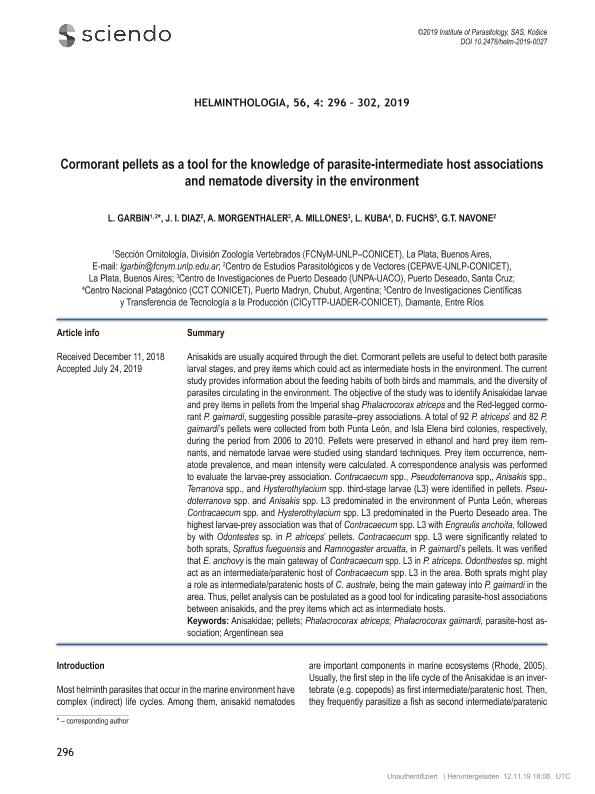Artículo
Cormorant pellets as a tool for the knowledge of parasite-intermediate host associations and nematode diversity in the environment
Garbin, Lucas ; Diaz, Julia Inés
; Diaz, Julia Inés ; Morgenthaler, Annick; Millones, Ana; Kuba, Luisa
; Morgenthaler, Annick; Millones, Ana; Kuba, Luisa ; Fuchs, Daniela Viviana
; Fuchs, Daniela Viviana ; Navone, Graciela Teresa
; Navone, Graciela Teresa
 ; Diaz, Julia Inés
; Diaz, Julia Inés ; Morgenthaler, Annick; Millones, Ana; Kuba, Luisa
; Morgenthaler, Annick; Millones, Ana; Kuba, Luisa ; Fuchs, Daniela Viviana
; Fuchs, Daniela Viviana ; Navone, Graciela Teresa
; Navone, Graciela Teresa
Fecha de publicación:
05/11/2019
Editorial:
Versita
Revista:
Helminthologia
ISSN:
0440-6605
Idioma:
Inglés
Tipo de recurso:
Artículo publicado
Clasificación temática:
Resumen
Anisakids are usually acquired through the diet. Cormorant pellets are useful to detect both parasite larval stages, and prey items which could act as intermediate hosts in the environment. The current study provides information about the feeding habits of both birds and mammals, and the diversity of parasites circulating in the environment. The objective of the study was to identify Anisakidae larvae and prey items in pellets from the Imperial shag Phalacrocorax atriceps and the Red-legged cormorant P. gaimardi, suggesting possible parasite-prey associations. A total of 92 P. atriceps' and 82 P. gaimardi's pellets were collected from both Punta León, and Isla Elena bird colonies, respectively, during the period from 2006 to 2010. Pellets were preserved in ethanol and hard prey item remnants, and nematode larvae were studied using standard techniques. Prey item occurrence, nematode prevalence, and mean intensity were calculated. A correspondence analysis was performed to evaluate the larvae-prey association. Contracaecum spp., Pseudoterranova spp, Anisakis spp., Terranova spp., and Hysterothylacium spp. third-stage larvae (L3) were identifi ed in pellets. Pseudoterranova spp. and Anisakis spp. L3 predominated in the environment of Punta León, whereas Contracaecum spp. and Hysterothylacium spp. L3 predominated in the Puerto Deseado area. The highest larvae-prey association was that of Contracaecum spp. L3 with Engraulis anchoita, followed by with Odontestes sp. in P. atriceps' pellets. Contracaecum spp. L3 were significantly related to both sprats, Sprattus fueguensis and Ramnogaster arcuatta, in P. gaimardi's pellets. It was verifi ed that E. anchovy is the main gateway of Contracaecum spp. L3 in P. atriceps. Odonthestes sp. might act as an intermediate/paratenic host of Contracaecum spp. L3 in the area. Both sprats might play a role as intermediate/paratenic hosts of C. australe, being the main gateway into P. gaimardi in the area. Thus, pellet analysis can be postulated as a good tool for indicating parasite-host associations between anisakids, and the prey items which act as intermediate hosts.
Archivos asociados
Licencia
Identificadores
Colecciones
Articulos(CCT - LA PLATA)
Articulos de CTRO.CIENTIFICO TECNOL.CONICET - LA PLATA
Articulos de CTRO.CIENTIFICO TECNOL.CONICET - LA PLATA
Articulos(CCT-CENPAT)
Articulos de CTRO.CIENTIFICO TECNOL.CONICET - CENPAT
Articulos de CTRO.CIENTIFICO TECNOL.CONICET - CENPAT
Articulos(CEPAVE)
Articulos de CENTRO DE EST.PARASITOL.Y DE VECTORES (I)
Articulos de CENTRO DE EST.PARASITOL.Y DE VECTORES (I)
Articulos(CICYTTP)
Articulos de CENTRO DE INV.CIENT.Y TRANSFERENCIA TEC A LA PROD
Articulos de CENTRO DE INV.CIENT.Y TRANSFERENCIA TEC A LA PROD
Citación
Garbin, Lucas; Diaz, Julia Inés; Morgenthaler, Annick; Millones, Ana; Kuba, Luisa; et al.; Cormorant pellets as a tool for the knowledge of parasite-intermediate host associations and nematode diversity in the environment; Versita; Helminthologia; 56; 4; 5-11-2019; 296-302
Compartir
Altmétricas



